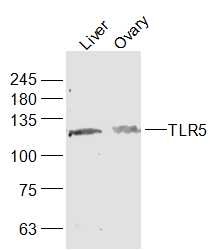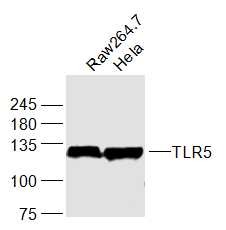Shopping Cart
Remove All Your shopping cart is currently empty
Your shopping cart is currently empty
Anti-TLR5 Polyclonal Antibody is a Rabbit antibody targeting TLR5. Anti-TLR5 Polyclonal Antibody can be used in WB.
| Pack Size | Price | USA Warehouse | Global Warehouse | Quantity |
|---|---|---|---|---|
| 50 μL | $220 | 7-10 days | 7-10 days | |
| 100 μL | $373 | 7-10 days | 7-10 days | |
| 200 μL | $528 | 7-10 days | 7-10 days |
| Description | Anti-TLR5 Polyclonal Antibody is a Rabbit antibody targeting TLR5. Anti-TLR5 Polyclonal Antibody can be used in WB. |
| Synonyms | Toll-like receptor 5, Toll/interleukin-1 receptor-like protein 3, TLR 5, TIL3 |
| Ig Type | IgG |
| Reactivity | Human,Mouse (predicted:Rat) |
| Verified Activity | 1. Sample: Liver (Mouse) Lysate at 40 μg Ovary (Mouse) Lysate at 40 μg Primary: Anti-TLR5 (TMAB-01858) at 1/1000 dilution Secondary: IRDye800CW Goat Anti-Rabbit IgG at 1/20000 dilution Predicted band size: 95 kDa Observed band size: 130 kDa 2. Sample: Raw264.7 (Mouse) Cell Lysate at 30 μg Hela (Human) Cell Lysate at 30 μg Primary: Anti-TLR5 (TMAB-01858) at 1/1000 dilution Secondary: IRDye800CW Goat Anti-Rabbit IgG at 1/20000 dilution Predicted band size: 95 kDa Observed band size: 130 kDa   |
| Application | |
| Recommended Dose | WB: 1:500-2000 |
| Antibody Type | Polyclonal |
| Host Species | Rabbit |
| Subcellular Localization | Membrane; Single-pass type I membrane protein (By similarity). |
| Tissue Specificity | Highly expressed in liver. Detected in lung and at very low levels in most other tissues. |
| Construction | Polyclonal Antibody |
| Purification | Protein A purified |
| Appearance | Liquid |
| Formulation | 0.01M TBS (pH7.4) with 1% BSA, 0.02% Proclin300 and 50% Glycerol. |
| Concentration | 1 mg/mL |
| Research Background | The Toll like receptor (TLR) family in mammal comprises a family of transmembrane proteins characterized by multiple copies of leucine rich repeats in the extracellular domain and IL1 receptor motif in the cytoplasmic domain. Like its counterparts in Drosophila, TLRs signal through adaptor molecules and could constitute an important and unrecognized component of innate immunity in humans. The TRL family is a phylogenetically conserved mediator of innate immunity that is essential for microbial recognition. TLRs characterized so far activate the MyD88/interleukin 1 receptor-associated kinase (IRAK) signaling pathway. Toll-like receptor 5 (TLR5) expression is upregulated following exposure to bacteria or to the TLR5 agonist, flagellin. Gram-negative bacteria, stimulate monocyte/macrophage cells in a TLR5-specific, CD14-independent manner. The TLR5 receptor thus appears to be the principal means by which the innate immune system recognizes flagellated bacterial pathogens. |
| Immunogen | KLH conjugated synthetic peptide: mouse TLR5 |
| Antigen Species | Mouse |
| Gene Name | TLR5 |
| Gene ID | |
| Protein Name | Toll-like receptor 5 |
| Uniprot ID | |
| Biology Area | Receptors,Macrophage / Inflamm.,TLR Signaling |
| Function | Participates in the innate immune response to microbial agents. Mediates detection of bacterial flagellins. Acts via MYD88 and TRAF6, leading to NF-kappa-B activation, cytokine secretion and the inflammatory response (By similarity). |
| Molecular Weight | Theoretical: 95 kDa. |
| Stability & Storage | Store at -20°C or -80°C for 12 months. Avoid repeated freeze-thaw cycles. |
| Transport | Shipping with blue ice. |
| Size | Quantity | Unit Price | Amount | Operation |
|---|

Copyright © 2015-2026 TargetMol Chemicals Inc. All Rights Reserved.